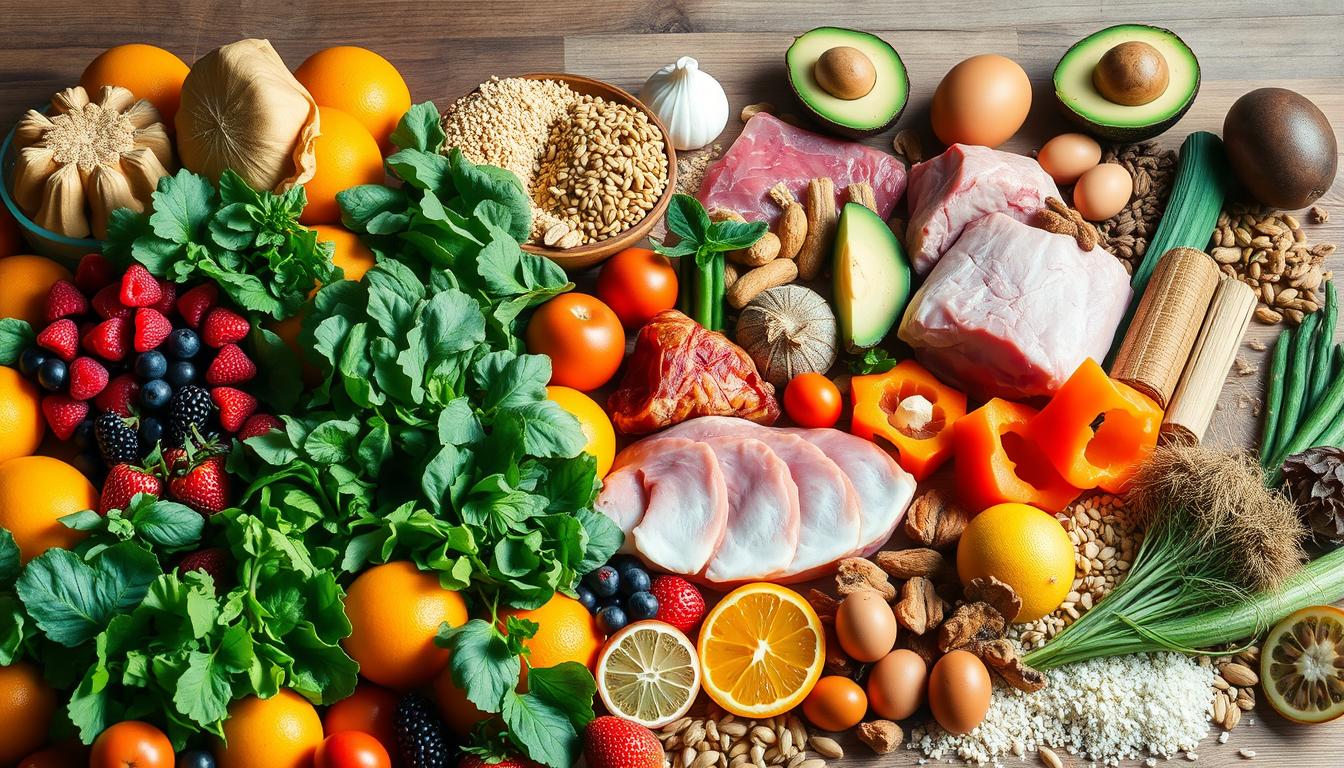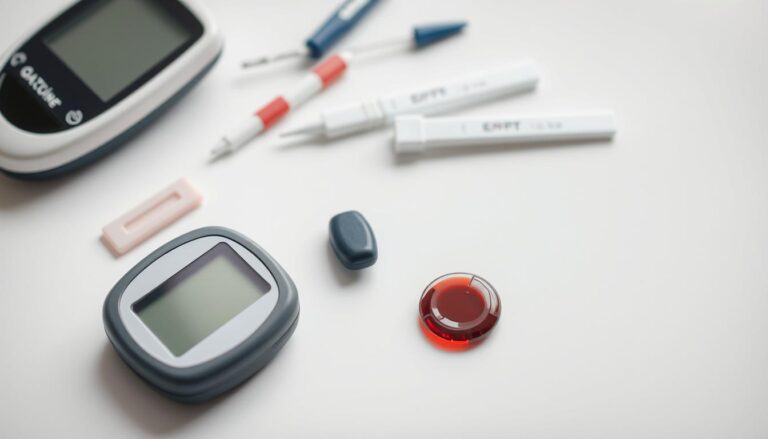Best Healthy Foods: How to Build a Balanced Diet
Table of Contents
Imagine making every bite count for your health. Nutrition isn’t about strict diets or hard meal plans. It’s about choosing foods that make you feel good and keep you healthy.
A balanced diet is your guide to feeling full of energy and staying well. It helps prevent serious health problems. Healthy foods are key to living your best life.
Most Americans eat too much sodium and sugar and miss out on important nutrients. Healthy foods can help you perform better and feel better. This guide will help you create a diet that fits your body.
Your journey to a balanced diet begins with seeing food as medicine. By picking foods rich in nutrients and eating mindfully, you can greatly improve your health and life quality.
Key Takeaways
- Nutrition is about nourishment, not restriction
- Every meal is an opportunity to support your health
- Whole foods provide the most nutritional benefits
- Small, consistent changes lead to significant health improvements
- Understanding nutritional basics empowers better food choices
Understanding the Foundations of Nutritious Eating
Nutrition is key to a healthy life. Your body needs a mix of nutrients to work well. Clean eating is more than a trend; it’s essential for health.
A balanced diet gives your body the fuel it needs. It supports your overall health. Understanding how nutrients work together is important.
What Makes a Diet Balanced
A balanced diet includes a variety of whole foods. These foods provide important nutrients. The aim is to make meals that are:
- Diverse in food groups
- Right in portion sizes
- Rich in nutrients
The Role of Macronutrients
Macronutrients are the main parts of your diet. Each one has a special role in your body:
- Carbohydrates: Your main energy source
- Proteins: Helps muscles repair and grow
- Fats: Important for hormone production and nutrient absorption
The Importance of Micronutrients
While macronutrients give you energy, micronutrients are vital for avoiding deficiencies. Vitamins and minerals help your immune system, bones, and metabolism.
Research shows that a balanced diet can greatly lower the risk of chronic diseases and support long-term health.
To get better results, you can benefit from the benefits of this nutritional supplement
Essential Components of a Healthy Foods List
Starting a healthy diet means knowing the key foods to eat. Your meals should be full of colorful, nutrient-rich foods. These foods help your body and keep you healthy. Organic produce is a must, as it’s packed with nutrients and has fewer pesticides.
Let’s look at the main parts of a healthy foods list:
- Fruits and Vegetables: The base of a good diet
- Whole Grains: Give you fiber and energy
- Lean Proteins: Help your muscles and recovery
- Healthy Fats: Important for your brain and hormones
Superfoods are key in your diet. They’re full of vitamins, minerals, and antioxidants. Foods like:
- Blueberries (10.8 milligrams of vitamin C per 3/4 cup)
- Salmon (full of omega-3s for your heart)
- Almonds (rich in vitamin E)
- Sweet potatoes (good for potassium and vitamin A)
“Your diet is a bank account. Good food choices are good investments.” – Bethenny Frankel
Studies show eating a variety of foods is good for your gut and health. Try to eat different, nutrient-rich foods. Choose whole, unprocessed foods for the best nutrition.
It’s not about being perfect, but making small, steady changes. These can greatly improve your health and happiness.
The Power of Nutrient-Dense Foods
Understanding nutrition is more than just counting calories. Nutrient-dense foods offer great health benefits with fewer calories. They are full of vitamins, minerals, and antioxidants that help your body work well.
Understanding Nutrient Density vs. Calories
Not all calories are the same. Nutrient density shows how much nutrition a food has compared to its calories. For instance, 100 calories of kale are much healthier than 100 calories of junk food.
- Low-calorie foods aren’t always healthy
- Quality matters more than quantity
- Nutrient-dense foods support overall health
Top Nutrient-Dense Food Choices
Some foods are especially good for you because of their nutrients. Foods high in antioxidants help fight off cell damage and keep you healthy for a long time.
| Food | Key Nutrients | Health Benefits |
|---|---|---|
| Kale | Vitamin K, C, A | Supports bone health, immune function |
| Salmon | Omega-3, Protein | Heart and brain health |
| Blueberries | Antioxidants | Reduces inflammation |
Maximizing Nutritional Value in Meals
Make your meals better by adding nutrient-rich foods. Strategic food combinations can help your body absorb nutrients better and get all the nutrition it needs.
- Mix colorful vegetables
- Include lean proteins
- Add healthy fats
- Choose whole grains
Remember, every bite is an opportunity to nourish your body with essential nutrients.
Building Your Plate with Proper Portions
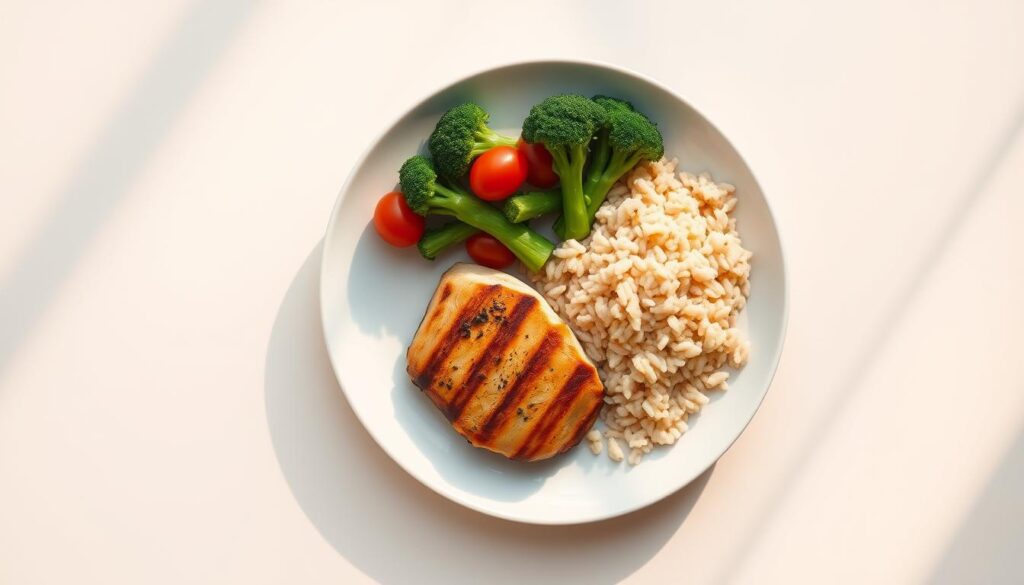
Starting a balanced diet means knowing how to fill your plate right. It’s all about portion control to keep your eating healthy and balanced. Think of your plate as a guide to eating clean and staying healthy.
The plate method is a simple way to make nutritious meals. Here’s how to split your plate for the best nutrition:
- Half the plate: Non-starchy vegetables (broccoli, carrots, spinach)
- Quarter of the plate: Lean protein sources (chicken, turkey, lean beef)
- Quarter of the plate: Quality carbohydrates (whole grains, starchy vegetables)
Knowing the difference between serving sizes and portion sizes changes how you eat whole foods. A big restaurant meal can have 1,500 calories. But, a well-portioned meal can be around 700 calories.
| Meal Type | Typical Calories | Balanced Plate Calories |
|---|---|---|
| Steak Dinner | 1,500 | 700 |
| Breakfast | 700 | 400 |
| Burrito Meal | 1,000 | 500-750 |
Your plate layout might change based on your age, how active you are, and your health goals. The main thing is to eat nutrient-dense foods and eat mindfully. Snacks should add fiber, protein, and healthy fats to keep you full.
Portion control is not about restriction, but about nourishing your body with the right amount of nutrients.
Learning to portion food well helps you get a balanced diet. This supports your health and well-being.
Whole Foods vs. Processed Foods: Making Smart Choices
Choosing between whole foods and processed foods can be tough. What you eat affects your health a lot. Knowing the difference helps you make better food choices.
Identifying Ultra-Processed Foods
Ultra-processed foods are not natural. They often have:
- Artificial ingredients
- High levels of added sugars
- Excessive sodium
- Preservatives and chemical additives
Adults get over 50% of their calories from these foods. Kids get 67% of their daily calories from them.
Benefits of Choosing Whole Foods
Whole foods are full of nutrients. They keep their natural goodness because they’re not processed much. Clean eating fans know organic foods are better for you.
- Retain natural vitamins and minerals
- Provide sustained energy
- Help control blood sugar levels
- Support overall metabolic health
Reading Food Labels Effectively
Learning to read food labels is key to picking healthy foods. The American Heart Association’s Heart-Check mark helps find better options. Look for:
- Lowest sodium content
- Minimal added sugars
- Recognizable ingredients
- Minimal chemical additives
Choosing whole foods and understanding food processing can improve your diet. Every meal is a chance to feed your body well with good, nutritious foods.
Plant-Based Foods for Optimal Health
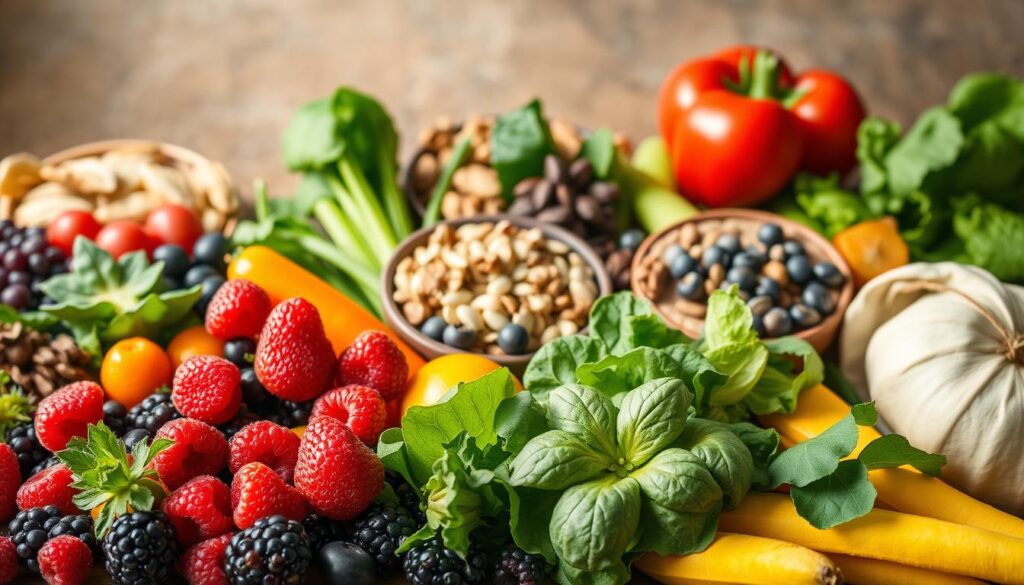
Switching to a plant-based diet can change how you view healthy eating. These foods are packed with antioxidants and vitamins. They help protect your body and keep you healthy.
Plant-based eating is about adding, not cutting out. Start small by making a few plant-based choices. This will help you get more nutrients into your diet.
- Kale: A nutritional powerhouse with only 9 calories per cup
- Dark chocolate (70-85% cocoa): Potential heart health benefits
- Colorful vegetables: Rich in essential nutrients and antioxidants
- Legumes: Excellent protein and fiber sources
Here are some nutrient-rich plant foods to add to your diet:
| Food | Key Nutrients | Health Benefits |
|---|---|---|
| Bitter Melon | Fiber, B Vitamins | Low-calorie nutritional support |
| Whole Grains | Complex Carbohydrates | Blood sugar management |
“Let food be thy medicine and medicine be thy food.” – Hippocrates
Don’t worry, you don’t have to go all in right away. Start by adding one plant-based meal each week. Talk to a nutrition expert to make sure you’re getting everything you need.
Protein Sources for a Balanced Diet
Protein is key for a good diet. It helps build muscle, keeps energy up, and boosts wellness.
The American Heart Association says to mix up your protein sources. This can be from animals or plants. Protein is vital for muscle and body functions.
Animal-Based Protein Options
Animal proteins are high in quality and protein. Here are some top picks:
- Skinless chicken breast (27 grams per 3-ounce serving)
- Lean ground beef (22 grams per 3-ounce serving)
- Salmon (19 grams per 3-ounce serving)
- Eggs (6 grams per large egg)
“Choose lean cuts with terms like ’round,’ ‘loin,’ or ‘sirloin’ for healthier protein sources.” – Nutrition Experts
Plant-Based Protein Alternatives
Plant proteins bring fiber and healthy fats. They’re great for those looking for different protein options:
- Lentils (18 grams per cup)
- Peanut butter (7 grams per 2 tablespoons)
- Tofu and beans
- Nuts and seeds
Optimal Protein Timing and Portions
How much protein you need depends on your age, weight, and activity. Here are some general tips:
| Category | Daily Protein Requirement |
|---|---|
| Sedentary Adult Male | 55 grams |
| Sedentary Adult Female | 45 grams |
| Active Adults | 0.8g per kilogram of body weight |
Spread out your protein intake all day for better absorption. Try to eat protein within 30 minutes after working out to help muscles recover.
Smart Carbohydrate Choices
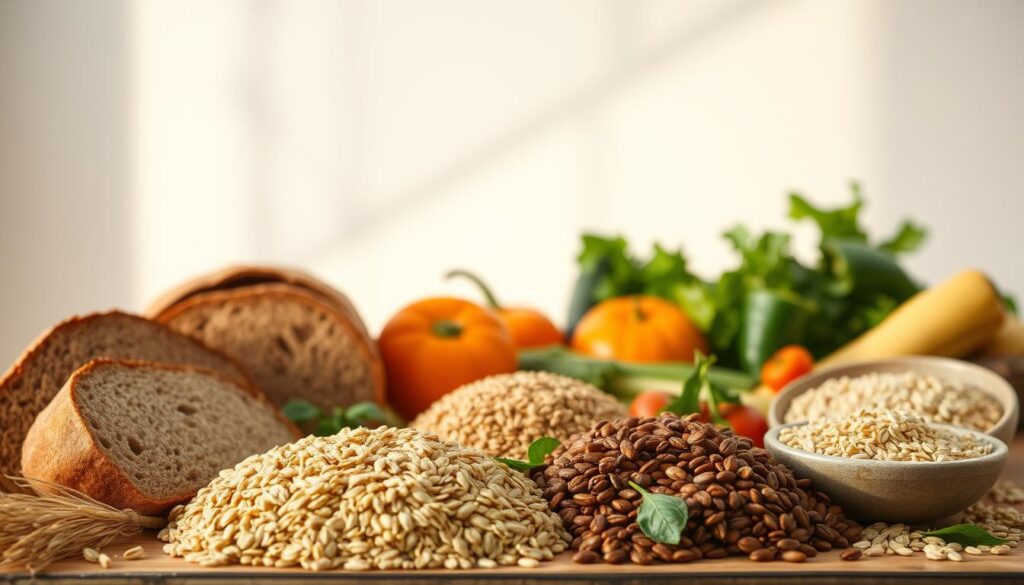
It’s important to know about smart carbs for a balanced diet. Not all carbs are the same. Choosing the right ones can boost your health and energy.
Smart carbs are foods that give you lasting energy and important nutrients. They take longer to digest, which helps keep your blood sugar stable. This makes you feel full for longer.
- Choose whole grains over refined options
- Prioritize fiber-rich carbohydrate sources
- Aim for at least 50% of grains from whole-grain sources
- Include diverse grains like quinoa, farro, and barley
When picking carbs, think about quality and how much you eat. The Dietary Guidelines for Americans say carbs should be 45% to 65% of your daily calories. For a 2,000-calorie diet, that’s about 225-325 grams of carbs.
Here are some tips for smart carb eating:
- Select foods with at least 3 grams of fiber per serving
- Include 1/2 to 1 cup of grains per meal
- Pair carbohydrates with protein to manage blood sugar
- Choose whole wheat flour as the first ingredient in bread
Eating nutrient-dense carbs is good for your health and helps with weight control. They give you the energy you need for your body and brain. By making smart choices, you can enjoy carbs as a tasty and essential part of your diet.
Healthy Fats and Their Important Role
Understanding healthy fats is key for good nutrition and a balanced diet. Not all fats are the same. Your body needs specific types to work right.
Healthy fats are crucial for many body functions. They help your body absorb vitamins and protect organs. They also give you energy for the day.
Essential Fatty Acids: Your Body’s Nutritional Allies
Some fats are called essential fatty acids because your body can’t make them. You must get them from food.
- Omega-3 fatty acids support heart and brain health
- Omega-6 fatty acids contribute to cell growth
- Monounsaturated fats help reduce bad cholesterol levels
Best Sources of Healthy Fats
Eating foods rich in healthy fats can boost your nutrition. The American Heart Association suggests certain fats:
- Fatty fish (salmon, mackerel)
- Nuts and seeds
- Avocados
- Olive oil
- Chia seeds
“Not all fats are harmful – some are essential for your health and well-being.”
Daily Fat Requirements
Your fat intake should be balanced. The AHA says to limit saturated fat to 5-6% of daily calories. Focus on healthy fats instead.
| Fat Source | Fat Content per Serving |
|---|---|
| Avocado (1/2 medium) | 14.7g |
| Chia Seeds (1 oz) | 8.7g |
| Olive Oil (1 tbsp) | 14g |
Choosing healthy foods with good fats helps meet your body’s needs. This keeps your diet balanced.
Meal Planning and Preparation Strategies
Learning to plan meals changes how you eat clean and whole. It saves time, reduces stress, and keeps your diet balanced. Studies show families can cut their grocery bills by 20% and eat healthier.
Good meal prep starts with smart plans:
- Create a master menu with flexible recipes
- Stock your pantry with versatile healthy foods
- Use ingredients in different ways
- Get ahead by preparing parts of meals early
Your kitchen setup is key for healthy eating. A digital scale helps with portion sizes. Buying grains like quinoa in bulk saves money. Keep ingredients for three backup meals ready for flexibility.
Time-saving tips can change your meal prep:
- Cook different parts of a meal at once
- Make quick meals with one-pot dishes
- Make big batches of staple foods
- Use slow cooking for easy meals
Using these tips makes healthy eating easier and fun. Remember, sticking to it is important for lasting healthy habits.
Conclusion
Building a balanced diet is more than just following rules. It’s about creating a lifestyle that nourishes your body. This journey with healthy foods doesn’t have to be hard. By making smart choices and understanding nutrition, you can change your eating habits for the better.
A balanced diet isn’t about being perfect. It’s about making consistent, thoughtful food choices. Nutritionists suggest eating whole foods that are full of nutrients. This means adding proteins, whole grains, leafy greens, and fruits like berries and avocados to your meals.
Small changes can make a big difference. Try choosing baked over fried foods or having protein-rich breakfasts. These changes can greatly improve your nutrition.
Your diet should be personal and flexible. Professional advice is helpful, but the best plan is one you can stick to. Look into healthy meal delivery services or try ingredients like chia seeds, fatty fish, and whole grains. With time and effort, you’ll find a diet that’s good for your health and enjoyable to follow.
Your nutrition journey is about empowerment. By knowing how your food choices affect your health, you’re investing in your well-being. Stay curious, keep learning, and enjoy the journey of nutritious eating.
FAQ
What exactly is a balanced diet?
A balanced diet gives your body all the nutrients it needs. It includes foods from different groups like whole grains, lean proteins, fruits, vegetables, and healthy fats. This mix helps keep you healthy, gives you energy, and prevents nutritional shortages.
How many servings of fruits and vegetables should I eat daily?
Nutritionists say eat at least 5-9 servings of fruits and vegetables every day. This ensures you get lots of antioxidants, vitamins, and minerals. These nutrients boost your immune system, aid digestion, and lower disease risks.
Are organic foods really better for my health?
Organic foods might have less pesticides and more nutrients. While not always necessary, picking organic for thin-skinned produce like leafy greens and berries can cut down on chemical intake.
What are superfoods, and do I really need them?
Superfoods are foods full of antioxidants, vitamins, and minerals. They’re good but not magical. Foods like blueberries, kale, salmon, and chia seeds can add to a balanced diet but shouldn’t replace it.
How can I control my portion sizes effectively?
Use the plate method: fill half with veggies, one-quarter with lean protein, and one-quarter with whole grains. Eat from smaller plates, measure servings, and eat slowly. This helps you stay mindful of when you’re full.
Is a plant-based diet nutritionally complete?
A well-planned plant-based diet can be complete. Include diverse protein sources like legumes, quinoa, tofu, and nuts. Make sure to get vitamin B12, iron, and omega-3s through supplements or fortified foods if needed.
How much protein do I actually need daily?
Protein needs vary by age, sex, weight, and activity level. Adults usually need 0.8 grams of protein per kilogram of body weight. Athletes or those building muscle might need 1.2-2.0 grams per kilogram.
Are all carbohydrates bad for me?
No, not all carbs are bad. Whole grains, fruits, and vegetables are key for energy and nutrients. Limit refined carbs like white bread and sugary foods instead.
What are the best sources of healthy fats?
Great sources of healthy fats include avocados, olive oil, nuts, seeds, fatty fish like salmon, and chia seeds. These foods support heart health, brain function, and reduce inflammation.
How can I make healthy eating more affordable?
Buy seasonal produce, frozen fruits and veggies, and bulk grains and legumes. Plan meals, choose generic brands, and shop at local farmers’ markets. Meal prepping can also cut down on waste and impulse buys.

